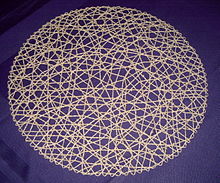Macrame
Macrame (Spanish spelling macramé ) denotes one from the East coming knotting technique for making ornaments , textiles and jewelery. Spanish macramé is derived from the Arabic migrama h . In Arabic usage, this stands for "weaving". Against this standsمقرمة / miqrama for "knotted veil". Macramé knot works of art range in size from a few centimeters to ten meters.
history
With the Crusaders and the Moors (via Spain) this technique came to Europe. Since then, it has experienced several heydays, during which very fine knotting was made. The last heyday in Germany was in the 1970s, with mostly very rustic looking works.
Found as
- Chinese macramé, said to bring good luck to the New Year
- Macramé owls, a traditional form of macramé
- Tablecloths, belts, wall hangings and much more
- Latin American macramé, especially jewelry (bracelets, necklaces, etc.)
- Uniform jewelry , badges of rank
Carrying thread and working thread
The threads that carry knots are called carrier threads . The threads that form knots are called work threads . Carrier threads never create loops . The difference can be clearly seen with a hanging basket , where the flower bowls are held by the carrying threads and decorated by the working threads.
Basic knot
There are essentially only two basic knots in macrame. For one thing , that's half the battle
Half lay (working thread laid going to the left )
and on the other hand the half knot .
Two half knots (tied differently) result in the wave knot (also called old women knot ). Started here left over right.
Rib knot
A rib knot is tied with two half-loops.
Square knot
The square knot (also called weaver or flat knot ) consists of two half knots . If the knots are tied around a strap like here, the square knot is also called the Salomon's knot .
Square knot with four strings
Square knot on the left
The two middle threads are the carrier threads and the two outer threads are the working threads. The right cord is put in a loop over the two middle threads to the left. The left cord lies over the right and is led to the right behind the two middle cords. Then it is passed from the back to the front through the loop of the right cord. The process is repeated, but this time the loop is made with the left outer thread and the right does what the left did previously.
Square knot on the right
The two middle threads are the carrier threads and the two outer threads are the working threads. The left cord is put in a loop over the two middle threads to the right. The right cord lies over the left and is led to the left behind the two middle cords. Then it is passed from back to front through the loop of the left cord. The process is repeated, but this time the loop is made with the right outer thread and the left does what the right did before.
A series of alternating left and right half knots or right and left half knots creates a ribbon of Solomon that does not twist and creates a straight pattern.
Wave knot
In macramé and plating , spiral patterns are created with the wave knot (also called old woman's knot ). This is where the name "wave knot" comes from.
The wavy or old woman's knot creates spiral patterns.
Wave knot with four cords
1. The middle two are the carrier threads and the outer two are the working threads. The right cord is placed in a loop over the two middle threads, the left cord lies over the right cord, is then led backwards behind the two middle threads, then pulled from back to front through the loop of the right cord.
2. This knot is repeated over and over again. Always start with the right loop. The row of equal overhand knots creates a twisted band , also called screw plating. A spiral pattern is created.
Decoration knot
Carrick Bend ( Josefine knot or pretzel knots ). It serves as a decorative knot.
application
Examples of belts
With ten working threads (blue) and one carrier thread (orange): the working threads lie lengthways to the viewer and the carrier thread across them. The belts are bounded above and below by a yellow “border thread”.
Belt with name and 480 rib knots / weave line. Knotted into a belt using
the Cavandoli technique
Individual evidence
- ^ JC Turner, Peter van de Griend: History and Science of Knots , p. 336.
- ↑ Kristin Möller: Knüpf-Design . Christophorus, Freiburg 2010, p. 7 .
literature
- Knorr, Elfride: New patterns for macrame knotting. Leipzig, G. Hedeler 1910. 12 sheets and 12 plates.
- Knorr, Elfride: Textbook for macrame knotting . Leipzig 1911. 23 pages, illustrated.
- Andersen, Eva: Macramé as art and hobby , Falken Verlag 1980, ISBN 3-8068-4085-7 .
- Willsmore, Heidy: Macramé, A Comprehensive Guide , Faber and Faber Ltd. 1979, ISBN 0-571-11310-9 .
- JC Turner, Peter van de Griend: History and Science of Knots. World Scientific Publishing Co. Pte. Ltd. Singapore, New Jersey, London, Hong Kong, 1996, ISBN 981-02-2469-9 .
- Bonny Schmid-Burleson: Creative macramé , Ravensburg 1974, ISBN 3-473-45400-1
See also
Web links
- Macrame instructions for friendship bracelets - with pictures and video
















